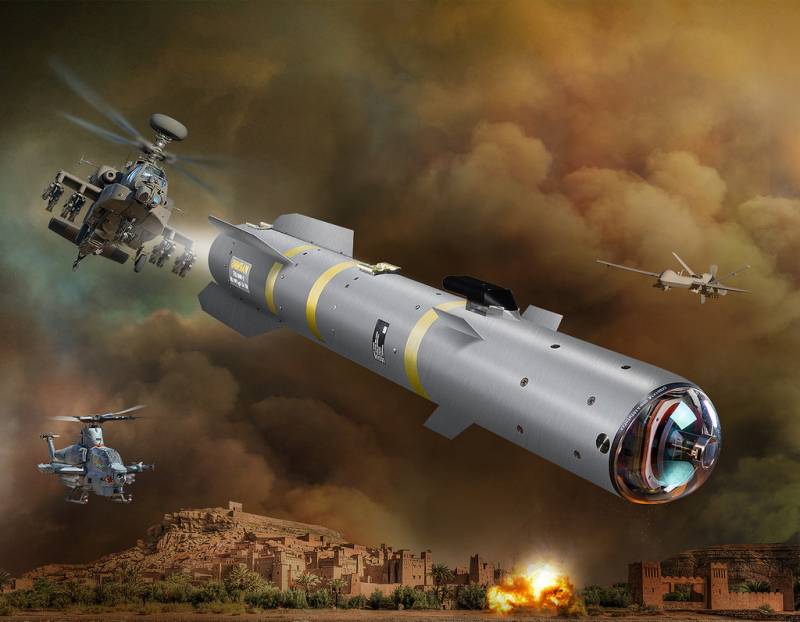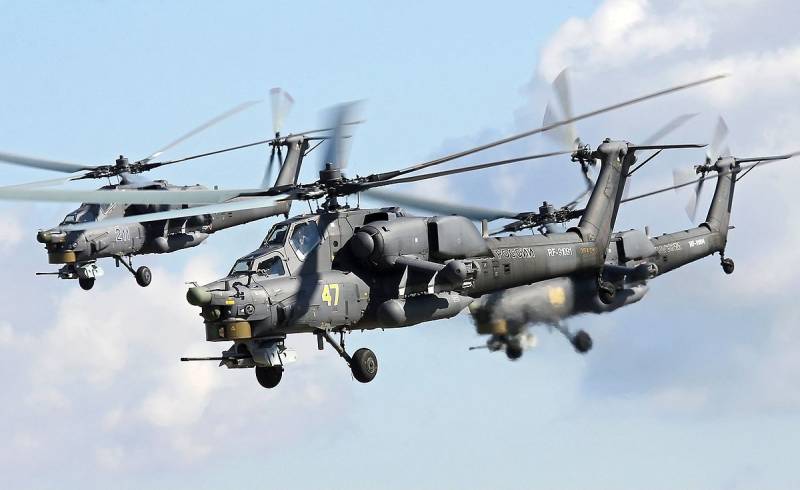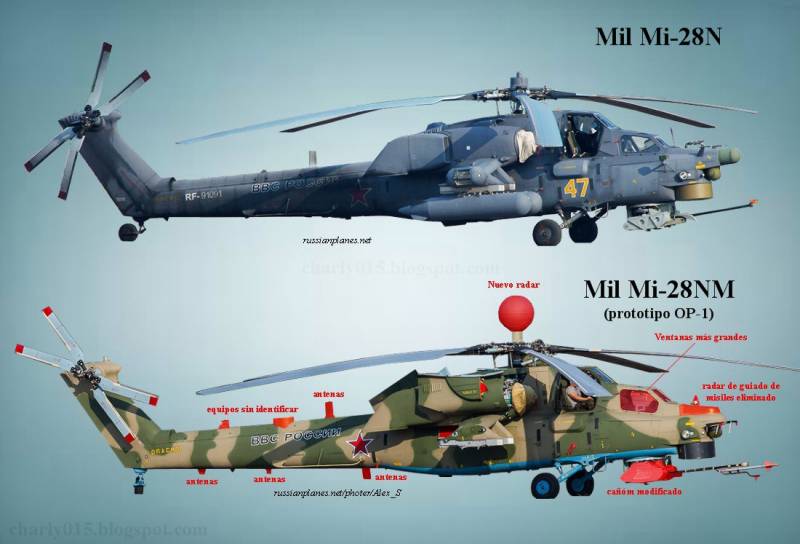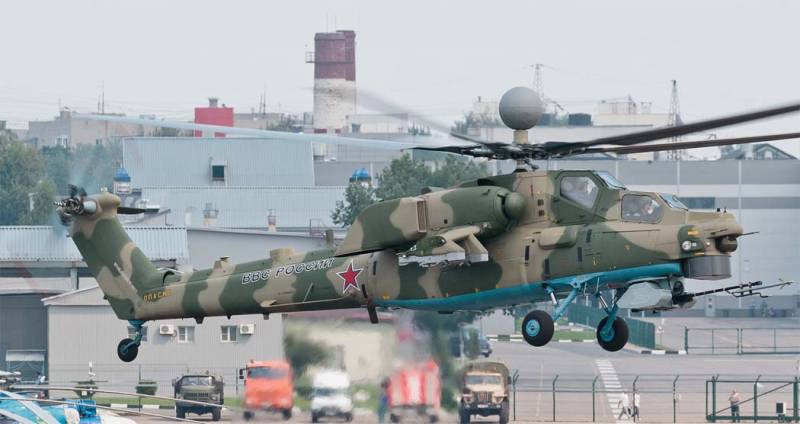Mi-28NM: catch up and overtake "Apache"
Compare strike helicopters is a thankless task. One of the reasons lies in the colossal experience of the helicopter industry. Over the long decades of confrontation, the United States and the USSR / RF have accumulated so much theoretical and practical knowledge that it is difficult to imagine a frankly unsuccessful attack helicopter. This, in general, also applies to most other helicopter-building countries. The rest, as they say, is a matter of taste: someone likes "Viper", someone - Ka-52. And someone is delighted with the Chinese WZ-10.
If, however, to abstract from personal preferences as much as possible, then you need to recognize that at the moment the most technologically advanced machine of this class is AH-64D Apache Block III or in another way AH-64E. It does not make sense to list all its advantages: briefly, the Americans were able to unleash the full potential of Apache Longbow. However, perhaps the most interesting lies not in the helicopter itself, but in its armament, although modern weapon this is, of course, the default complex of everything.
The new Apache, like a number of other US helicopters, will soon receive a new JAGM (Joint Air-to-Ground Missile) rocket instead of the usual Hellfire. Back in June, 2018, it became known that mass production began JAGM. Ammunition can hit targets at a range of up to eight kilometers. Its weight is approximately 50 kilograms. The rocket has an advanced dual-mode homing head: semi-active laser and radar. The tests showed that the Joint Air-to-Ground Missile is more reliable than its predecessor, and they also say that later its range can be increased to 16 kilometers. Of course, when launched at such a range, the requirements for the on-board electronics of the Apache helicopter will sharply increase. However, his rival in the person of the Mi-28H also has difficulties: both with avionics and with weapons.
Mi-28 as a concept
There is not the slightest doubt that the Night Hunter as a platform deserves the highest praise. Purely conceptual. The simplest example is a tandem crew layout. What not to say, and such a scheme is much more versatile than a side-by-side scheme, as in the Ka-52. It must be assumed that when the head of the crew is turned, it is better to see the surface and / or the likely enemy than the shoulder of the operator (however, again, how many people have so many opinions).
In general, the Mi-28 is potentially the best attack helicopter of the Russian Federation. But there are, as they say, the nuances that we mentioned above. One example. As is known, the ex-commander-in-chief of the VKS, Viktor Bondarev, after his resignation, “pulled” on frank statements. “Electronics failed: the pilot doesn't see anything, the pilot doesn't hear anything. These glasses, which they put on, they call "death to pilots". The sky is cloudless - everything is fine, and if there is a smoke, three days with red eyes go, ”said the military last November. This assessment did not concern the raw machines of the first installment, but quite a large-scale Mi-28H, which, in theory, should have revealed all (well or almost all) childhood diseases. Although this process is, of course, long and complicated, which also needs to be understood.
But the main drawback, which catches the eye almost immediately, is the absence of millimeter-wave radar on the combat vehicles, like the Apache Longbow. It provides well-known advantages in identifying ground targets, followed by aiming high-precision weapons at them. Provided the use of missiles with active radar homing heads AGM-114L Longbow Hellfire radar allows you to implement the notorious principle of "shot and forget." Without an overhead radar station and advanced air-to-surface weapons, the Mi-28H is very similar in its capabilities to the AH-64A. The main difference lies, perhaps, in the fact that the latter was built by a much larger series than all versions of the Mi-28 combined.
The first after "Longbow"
The most technologically advanced and potentially the most advanced modification of the Mi-28, as we see, did not appear on level ground. Mi-28HM was the result of numerous trial and error, as well as a response to the achievements of overseas "friends". The main thing that needs to be said in this case is: this is not a “paper” project or an idea for the future. Flight tests of the Mi-28HM attack helicopter began on October 12, 2016 at the Moscow Helicopter Plant. M.L. Mil. Then the first prototype of the OP-1 rose into the air. The event was overseen by the Deputy Minister of Defense of Russia, Yuri Borisov. It was reported that the first flight of the Mi-28HM was successful and all the systems of the machine worked normally.
Purely visually, the main difference of a new machine from all previous versions is the “cut” nose part. There is one important improvement that does not immediately strike the eye. The helicopter operator received a much better side view due to the significantly modified cockpit canopy. By the way, the experience gained while working on the Mi-XNUMHUB was not in vain. In front of the cockpit of the new helicopter installed a second set of controls, which certainly gives new opportunities: both in terms of crew training, and in terms of increasing the survivability of the combat vehicle in real combat. Another good point. Within the framework of the project, Mi-28НМ previously offered to use the new VK-28П-2500 / ПС engines, which can be produced by the Russian defense industry and which meet the basic requirements of modernization.
The most important improvement concerns the same radar headset. She (perhaps in the form of a layout) is present on the prototype OP-1. In any case, it was previously stated that a full-scale installation of an N025 type nadvtulochny radar is planned. According to reports, it is sensitive enough to detect a small UAV 20 kilometers away. It was reported that the radar allows the crew to accompany up to ten targets and to direct weapons at two of them. It is believed that Russian sensors of this type are able to detect a moving target of the type “tank” at a distance of the order of 20-25 km. Also very important is the theoretical possibility of using missiles with a radar guidance system, which should provide the helicopter with the utmost secrecy. For the sake of interest, you can see the photo, where it can be seen that from the “Apache”, which is in the shelter, only the strap-up radar “sticks out”.
And here the most interesting begins. Does Russia have missiles that could be compared in its capabilities with the JAGM? Well, or at least with AGM-114L Longbow Hellfire? “Sturm” and “Whirlwinds” with a laser guidance system, limiting the pilot space for maneuver after launch, will not surprise anyone. About Hermes-A, which was positioned almost as a miracle weapon, has been almost suspicious for a long time. It is worth recalling, however. The range of this ATGM should be approximately 15 kilometers. The manufacturer claims an optical-electronic system with optical capture and target tracking with control of a rocket flight over a laser beam. In general, there is the makings of a “shot-and-forget” principle, but so far everything is very vague.
There is an alternative. In August, the International Military-Technical Forum "Army-2018" was held in Moscow in 2018. There, the Russian Helicopters JSC presented a modified version of the export Mi-28НЭ equipped with long-range anti-tank 9М123М Chrysanthem-VM with a two-channel guidance system - using a laser beam and a radio channel. Here it is appropriate to recall one statement 2016 of the year. “We are carrying out modernization of the“ Attack ”and“ Chrysanthemum ”missiles to ensure a higher detection range, capture and destruction of targets specifically for the Mi-28HM. The complex of guided missile armaments aboard the helicopter is being adapted for new missiles, ”Valery Kashin, General Designer of the Kolomna Engineering Bureau, told TASS.
As we see, the new Mi-28HM risks staying: either a) with openly old Soviet missiles, or b) with an ATGM, whose obsolescence will become noticeable in the coming years. The available products, apparently, are far from JAGM in their capabilities, so the development of fundamentally new anti-tank missiles could become one of the priorities in increasing the combat potential of attack helicopters of the Russian Aerospace Forces.




Information